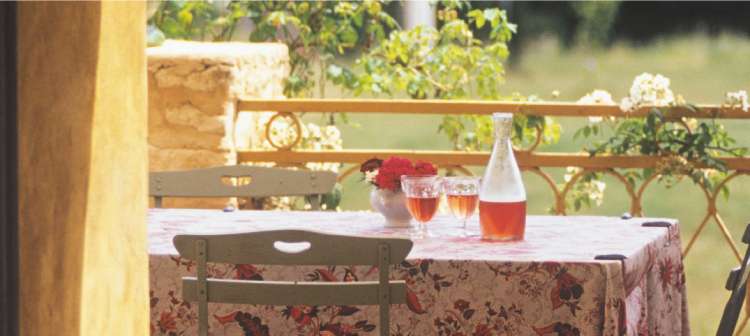Producers in the pink as 'youthful' rosé becomes a French fashion

Some French wine growers are rioting. Others are in the pink. Rosé, once the mocked poor relation of French vineyards, has overtaken white wine in volume of sales in France for the first time.
Pink wine, drunk chilled in the summer, is defying the persistent trends of under-consumption and over-production in the traditional red and white sectors of the French wine industry.
Estimates show at least one in five bottles of wine sold in France is now a rosé, compared to one in 10 a decade ago. This summer – depending how high the July and August temperatures go – pink wine sales may exceed half of all the bottles sold in France. A similar boom is gathering strength in Britain and the US.
Rosé, long considered a non-wine by purists, has become the tipple of choice for young French people who regard it as more youthful, more fun and less intimidating than their reds and whites.
Small growers in the Languedoc region in the French deep south, the traditional home of cheap, coarse "rouge", rioted in protest against the low prices of generic red wine this week.
In the traditional rosé-producing regions – Provence in the south-east and Anjou in the Loire valley – all is quiet and content. Growers are enjoying a vie en rose, unconcerned (almost) by attempts by other regions to climb aboard the pink bandwagon.
Burgundy and Bordeaux, the aristocracy of French wine regions, once entirely committed to reds and whites, have started to develop rosé labels. In Bordeaux, there has been a revival of the word clairet, or clearish, for pink wine. It was this expression which produced the word claret in English, suggesting that in past centuries red wines from Bordeaux may not have been as dark as they are today.
Pierre Aguilas, 64, is among the most senior figures in the French wine industry, a member of the national committee that governs Appellations d' Origine Côntrolées, the 466-odd French wines which have the legal right to a local or regional name. He is also a producer of red, white and rosé wines.
"Twenty years ago, people were saying rosé was doomed," M. Aguilas said. "Now the demand is phenomenal. Young people especially, and women, have taken to rosé as a pleasure drink, a youthful drink, something which goes well with foreign food, such as Indian and Chinese or pizza, but also something that can be drunk chilled on a hot day just for the fun of it.
"This is obviously wonderful news for us here in Anjou, since we produce some of the finest rosé wines anywhere. What worries me is that some new producers will just throw their rosé together in a piggish way. A lot of bad, new rosé wines – what I call pizza rosé – would be bad news for all of us."
There have been rosé wine booms, and busts, before, in the 1970s, for example. M. Aguilas fears this could happen again.
Rosé is white wine made from red-wine grapes. In character, it is like a white wine but it is, in truth, a form of light, red wine, in which the red pigments, and tannins, from the grape-skins and seeds and pulp are reduced to a minimum.
The notion that rosé is just an industrial by-product of red wine explains, in part, its poor reputation among purists. The lack of tannins, because the skins and seeds are included only briefly in the wine-making, means rosé cannot be kept for long periods. It cannot become a complex, vintage wine like a fine red or white.
Mr Aguilas says none of that justifies the anti-rosé prejudice of some wine-lovers. "Rosé is actually one of the hardest of all wines to make well," he said. "To capture the freshness, the delicate balance of tastes and aromas, in a young wine like a rosé is a real challenge. There is no reason why that should not be prized as much as a wine which has been kept for years.
"It is like the difference between perfume and fresh flowers. We appreciate the aroma of perfumes. But we also love the aroma of fresh flowers. To drink a good rosé is like smelling a bouquet of flowers."
Rosé sales in France are said to have reached 22 per cent last year, overtaking white wine which slumped to 18 per cent. Rosé sales in Britain have almost doubled in five years. But UK sales of French rosé are slumping, say French growers, pushed out by cheap, brightly labelled Californian rosés.
Three top French rosés for summer, chosen by Mark O'Halleron of Decanter
*Rosé des Tourelles, Bordeaux 2006
Top-notch, sophisticated rosé from prestigious properties in Bordeaux (Château Pichon Longueville-Baron). Supremely polished with lovely balance and plenty of red berry fruit flavours.
£11.99 Handford Wines, Whole Foods Market, Bibendum Wine.
*Domaine Maby, La Forcadière Rosé, Tavel 2007
From Tavel in the Rhône valley, this pink delight is a world away from the over-sweet, sticky Blush Zinfandels that sell by the crate in the UK. Made in a traditional, more rustic style, it's deep in colour yet crammed with fresh red fruit and flower notes.
£9.95 Yapp Brothers www.yapp.co.uk 01747 860423.
*Cháteau Cavalier, Provence 2007
Classic, pale and dry, this wine ticks all the boxes for summer, with its delicate palate of soft, strawberry fruit and a crisp finish. Perfect for salads.
£7.99 Oddbins and Nicolas stores.
Top tipples for summer
Join our commenting forum
Join thought-provoking conversations, follow other Independent readers and see their replies
Comments